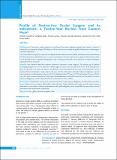Please use this identifier to cite or link to this item:
https://hdl.handle.net/20.500.14356/1096| Title: | Profile of Destructive Ocular Surgery and its Indications: A Twelve-Year Review from Eastern Nepal |
| Authors: | Chaudhary, Santosh Shah, Sangeeta Lavaju, Poonam Shrestha, Bhuwan Govinda Pant, Aashish Raj Badhu, Badri Prasad |
| Citation: | ChaudharyS., ShahS., LavajuP., ShresthaB. G., PantA. R., & BadhuB. P. (2021). Profile of Destructive Ocular Surgery and its Indications: A Twelve-Year Review from Eastern Nepal. Journal of Nepal Health Research Council, 19(2), 246-251. https://doi.org/10.33314/jnhrc.v19i2.3150 |
| Issue Date: | 2021 |
| Publisher: | Nepal Health Research Council |
| Article Type: | Original Article |
| Keywords: | Eye globe infection neoplasia orbit |
| Series/Report no.: | Apr-June, 2021;3150 |
| Abstract: | Abstract Background: Destructive ocular surgeries are performed for many conditions ranging from trauma to tumours, where the eyes cannot be salvaged. The objective of our research was to study the profile of destructive ocular surgery and their indications. Methods: This retrospective study reviewed all patients who underwent evisceration, enucleation, and exenteration at B.P. Koirala Institute of Health Sciences, a tertiary eye hospital in Eastern Nepal, between January 2008 and December 2019. Medical records on patient demographics, type of surgery performed, and an indication of surgery during the study period were reviewed. Results: One hundred thirty-four patients underwent destructive ocular surgeries. The median age of patients undergoing surgery was 14.5 (3-50) years. Children aged ten years or less accounted for 46.3% of the total patients. Fifty-two percent were male. The left eye was affected in more than half of the cases (56.7%). Enucleation was the most performed destructive ocular surgery (76 cases, 56.7%). Intraocular and ocular adnexal malignancy was the most common overall indication (62 cases, 46.3%). Ocular infection (19 cases, 41.3%) and trauma (15 cases, 32.6%) were the most common indication of evisceration. Retinoblastoma accounted for most cases of enucleation (43 cases, 56.6%). Malignancy was the only indication of exenteration (12 cases, 100%). Conclusions: Enucleation was the most common destructive ocular surgery. Malignancy accounted for most of the cases of destructive eye surgery, followed by ocular infection. Ocular infection and trauma were the most common indication of evisceration, whereas retinoblastoma and eyelid malignancy were responsible for most of the cases of enucleation and exenteration, respectively. Keywords: Eye; globe; infection; neoplasia; orbit |
| Description: | Original Article |
| URI: | http://103.69.126.140:8080/handle/20.500.14356/1096 |
| ISSN: | Print ISSN: 1727-5482; Online ISSN: 1999-6217 |
| Appears in Collections: | Vol. 19 No. 2 (2021): Vol 19 No 2 Issue 51 Apr-Jun 2021 |
Files in This Item:
| File | Description | Size | Format | |
|---|---|---|---|---|
| 3150-Manuscript-23758-1-10-20210907.pdf | Fulltext Download | 672.51 kB | Adobe PDF |  View/Open |
Items in DSpace are protected by copyright, with all rights reserved, unless otherwise indicated.
